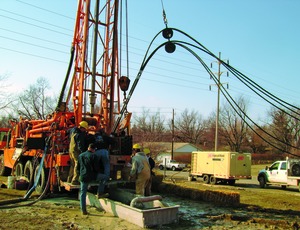
Digging 3,600 holes within the boundaries of an active 660-acre campus of 22,000 students might seem to be a logistical nightmare.
Even before the ground-source, geothermal district and heating system installation is finished, its complicated construction is paying off. In early testing the system is producing more than seven times the amount of heat or cooling for every unit of electricity used. In other words, the network is 700% efficient, "one of the highest [ratings] we've seen," says Jim Lowe, director of facilities planning and management at the university.
The $80-million system is a little more than half-built. When finished, 3,600 boreholes between 400 ft and 500 ft deep will be connected by more than 1,000 miles of pipe and tubing through 45 buildings on the campus.
The geothermal system will heat and cool almost the entire campus and will yield fuel and operational savings of about $2 million a year, says Lowe.
John Kelly, manager of operations for the Washington, D.C.-based nonprofit Geothermal Exchange Organization, says that to his knowledge, the Ball State system is the largest of its kind in the world. "It's a huge project," he says.
Public schools, from elementary up, are the biggest market for such geothermal ground source heating and cooling systems because of their overall cost effectiveness, Kelly says. Colleges and universities are particularly suited to geothermal—many currently use coal-fueled boilers and "there's a lot of sensitivity to" coal on many campuses, he says.
More than a decade ago, Ball State looked at replacing its four 50- and 60-year-old coal-fired boilers, Lowe says. The university initially intended to get new boilers that could burn 70% coal and 30% alternative fuel. When costs climbed above Ball State's comfort level, university administrators began examining how to make ground-source geothermal work on campus, Lowe says.
Ball State received $45 million from the state and an additional grant of $5 million from the U.S. Dept. of Energy. With that money, it hired MEP Associates of Eau Claire, Wis., to design and engineer the system.
Drilling the first set of boreholes began in July 2009 and took place non-stop until the fall of 2010.
"One of the bigger challenges has been finding a corridor—a pathway for this completely new system on a mature campus," Lowe says. "We had to do this enormous project, yet the campus had to be functional."
Crews are drilling the second set of 1,800 boreholes, but the school doesn't have the money yet to finish the job. Lowe said there is no set end-date. The system will include four heat pumps, each with a capacity of 2,500 tons of cooling per hour and 38 million BTUs per hour of heating. The system is expected to use 11.5 million kWh per year, but that electricity should yield more than 80.5 million kWh of heating and cooling power.
When complete, Lowe says that cost of installing the geothermal system, compared with replacing the boilers, will be paid off within seven to 10 years. In addition, the campus won't be burning 36,000 tons of coal per year.
Lowe says he gets about a call a day about the system from another school or group. Geology students from Ball State are actively participating in the project, and students in other fields of study are also learning from the project, he says.
In the end, Ball State's students may have more of an impact on the geothermal industry in the U.S. than the project itself, Kelly says. The biggest barrier to more geothermal installations is a lack of engineers and architects familiar with geothermal systems. He says that geothermal heat pumps account for about 2% of the cooling and heating systems in the U.S.
"There is a knowledge barrier" to geothermal, Kelly says. "That's one of the great things about Ball State: It is educating a group of future [geothermal] technical experts."


Post a comment to this article
Report Abusive Comment